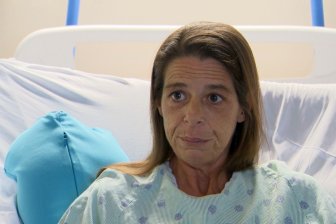A global campaign is colouring the world orange in order to raise awareness about a chronic pain condition called “Complex Regional Pain Syndrome” (CRPS).

Frederictonian Carrie Brewer is one of 9,000 Canadians diagnosed with the condition each year.
After injuring her left wrist in a car accident in 1993, Brewer began experiencing continuous intense burning pain — pain that was out of proportion to the original injury.
Six months after the accident Brewer was diagnosed with CRPS and has experienced severe pain for more than 20 years.
“I can smile while I’m in pain because if I didn’t I’d never smile,” Brewer said.
Since going off narcotic pain killers in 2013, Brewer says she’s learned to cope with the pain through Cognitive Behavioural Therapy (CBT) and physio therapy. She says photography has helped her keep her focus off the pain.
According to experts, the chronic condition can affect any part of the body and usually stems from fractures, surgery or soft tissue injuries.
According to Helen Small, executive director of P.A.R.C. which helps provide information and awareness about the condition, early diagnosis is key.
“It’s extremely important that it be diagnosed early so that it can be treated effectively,” Small said.
She says if the condition is left untreated, there is a higher chance the pain could spread to other parts of the body — causing more problems.
“If you suspect that you have it, you should get and get it checked out because a lot of doctors don’t know about about it. They don’t know to diagnose and they don’t know how to treat it,” Small said.
“Right now when we go into hospitals there are doctors and nurses that don’t know what this it. It’s getting less and less, but it happens,” Brewer said.
On November 7, landmarks across the world will be lit-up orange to raise awareness — including Edmonton’s High Level Bridge, Calgary Tower, and Niagara Falls will glow orange later this month — along with lots of other landmarks. Orange represents the burning pain associated with the condition.
Brewer says seeing the support and orange lights the past two years has been a sign of hope.
“There’s a bit of pride there. We’ve tried for many years to get things done and finally we’re getting some things done,” Brewer said.
Small says the pain experienced by CRPS patients is higher than the pain experienced by people coping with cancer.
“It’s rated higher than cancer pain on the McGill Pain Index. Cancer pain is rated 28, and out of 50, CRPS is rated 42. It’s rated higher than labour pain,” Small said.
- Canadian man dies during Texas Ironman event. His widow wants answers as to why
- Invasive strep: ‘Don’t wait’ to seek care, N.S. woman warns on long road to recovery
- ‘Sciatica was gone’: hospital performs robot-assisted spinal surgery in Canadian first
- ‘Super lice’ are becoming more resistant to chemical shampoos. What to use instead




Comments